|
January 2nd is National Swiss Cheese Day. After a brief explanation of “Swiss” cheese, we’ll head into all of the year’s cheese holidays, below.
> The history of cheese.
> The different types of cheese: a glossary.
> The year’s 30 cheese holidays are below.
THERE IS NO ONE SINGLE “SWISS” CHEESE
Swiss cheese is the generic name used in the U.S. for several related varieties of cheese, inspired by those made in Switzerland.
Emmental (photo #1), which has large holes (properly known as eyes*), is the original cheese from Switzerland that Americans think of as “Swiss” cheese. Not all kinds of cheeses made in Switzerland have them.
In fact, there are some 450 known Swiss cheeses, classified into five categories:
The categories of Swiss cheese, and examples, include:
Extra-Hard: Sbrinz
Hard: Emmental (or Emmenthal, Emmenthaler or Emmentaler), Gruyère/Greyerzer (photo #4), Sapsago, Vacherin Fribourgeois
Semi-Hard: Appenzeller (photo #3), Bündner Bergkäse, Mutschli, Raclette, Tête de Moine, Tilsiter
Semi-Soft: Vacherin Fribourgeois (photo #5), Vacherin Mont d’Or (photo #5)
Soft: Gala (fresh cheese), Tomme Vaudoise
Cow’s milk is used in 99% of the cheeses produced (the same goes for Swiss-style cheeses made in the U.S.).
When émigré cheesemakers from Switzerland arrived in the U.S., some made Emmenthaler-style cheeses which they sold as “Swiss cheese” (photo #2).
As a result, most Americans think of “Swiss cheese” as the cheese with big holes.
If you’re a “Swiss cheese” lover, try some authentic Emmental and taste the difference.
THE YEAR’S 30 CHEESE HOLIDAYS
January
January 2nd: National Swiss Cheese Day
January 19th: World Quark Day
January 20th: National Cheese Lover’s Day
February
February: National Fondue Month
February 13th: National Cheddar Day
March
March 5th: National Cheese Doodle Day
April
April: National Grilled Cheese Month
April 9th: National Pimento Cheese Day
April 11th: National Cheese Fondue Day
April 11th: National Poutine Day
April 17th: National Cheese Ball Day
April 20th: International Raw Milk Cheese Appreciation Day
April 20th: National Cheddar Fries Day
May
May 18th: National Cheese Soufflé Day
June
June 4th: National Cheese Day
June 25th: National Goat Cheese Day
July
July 14th: National Mac & Cheese Day
July 25th: National Wine & Cheese Day
July 29th: National Cheese Sacrifice Purchase Day
July 30th: National Cheesecake Day (savory cheesecake recipes)
August
August: National Goat Cheese Month
September
September 5th: National Cheese Pizza Day
September 15th: National Cheese Toast Day
September 18th: National Cheeseburger Day
September 20th: National Queso† Day
September 20th: National String Cheese Day
September 26th: National Cream Cheese Day
October
October 9th: National Moldy Cheese Day
October 15th: National Cheese Curd Day
November
November: National Fun With Fondue Month
________________
*Three types of bacteria are used in the production of Emmental cheese: Streptococcus thermophilis, Lactobacillus, and Propionibacter shermani. In a late stage of cheese production, P. shermani consumes the lactic acid excreted by the other bacteria and releases carbon dioxide gas. This forms the bubbles that appear to be “holes” when the cheese is sliced. These bacteria are also used in the production of some other cheeses from Switzerland. The cheese industry calls these holes or tunnels “eyes.” Swiss cheese without eyes is known as “blind.”
†Queso is a cheese dip that is historically baked (queso fundido/queso flameado). In recent decades, it has been made into a pasteurized cheese dip and sold in jars like salsa. The recipe in the link is a muenster dip but you can substitute Cheddar, Jack, or a Hispanic melting cheese.
|
|
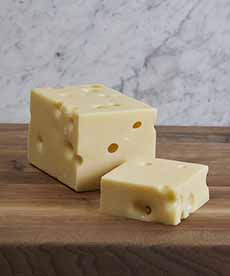
[1] Emmenthaler cheese from Switzerland (photo © DeLaurenti).
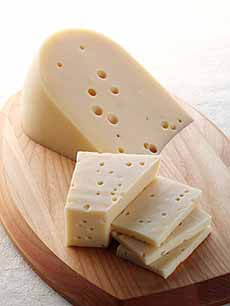
[2] Swiss émigrés to the U.S. made cheese according to the Emmenthaler recipe they knew, but sold the cheese as “Swiss cheese” (photo © Wisconsin Cheese).
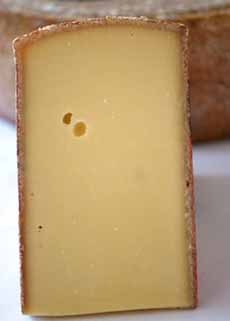
[3] Appenzeller cheese (photo © Artisanal Cheese).
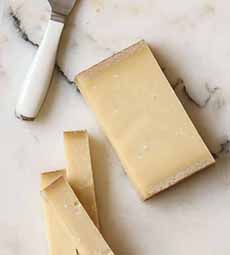
[4] Gruyère. Swiss Gruyère is the original, with A.O.P. protection. Gruyère is also made on the other side of the border in France, but it must be labeled “French Gruyèere” (photo © Murray’s Cheese).
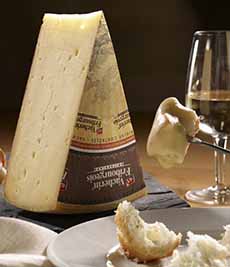
[5] Vacherin Fribourgeois. The canton of Fribourg (also the canton of Freiburg) is located in western Switzerland. Vacherin refers to a type of soft Swiss cow’s milk cheese. There are also French vacherins (photos #5 and #6 © Cheeses From Switzerland).

[6] Silky and luscious Vacherin Mont d’Or is crafted from cow’s milk produced during the fall and winter months when the herds spend their days munching straw and fodder instead of grazing on pasture. When ripe the cheese is spoonable/spreadable. Mont d’Or is a mountain that lies between the Swiss canton of Vaudo and the French Jura.
|








